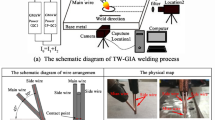Abstract
Research on regularity of indirect arc shapes change with variation of applied magnetic field is studied. Results show that indirect arc would be elongated or compressed in XOZ plane with variation of applied transverse magnetic field’s direction and intensity, while the indirect arc would be deflected with the application of longitude magnetic field in YOZ plane, and the deflection degree and direction will be also changed by the variation of longitude magnetic field’s intensity and direction. It is considered that change of arc shapes is caused by variation of arc forces. The influence of Ampere force on indirect arc deformation and deflection is analyzed in this paper.
Similar content being viewed by others
References
Cao M Q, Zou Z D. Electric arc shape of twin-wire indirect arc welding. Transactions of the China Welding Institution, 2006, 27(12): 50–52 (in Chinese)
Zhang S-S, Cao M-Q, Wu D-T, et al. Effects of process parameters on arc shape and penetration in twin-wire indirect arc welding. Frontiers of Materials Science in China, 2009, 3(2): 212–217
Karadeniz E, Ozsarac U, Yildiz C. The effect of process parameters on penetration in gas metal arc welding process. Materials & Design, 2007, 28(2): 649–656
Suban M. Tuek. J. Dependence of melting rate in MIG/MAG welding on the type of shielding gas used. Journal of Materials Processing Technology, 2001, 119(1–3): 185–192
Tanaka M, Tashiro S, Ushio M, et al. CO2-shielded arc as a high-intensity heat source. Vacuum, 2006, 80(11–12): 1195–1198
Lu S. Marangoni convection and weld shape variation in Ar-O2 and Ar-CO2 shielded GTA welding. Materials Science and Engineering A, 2004, 380(1–2): 290–297
Guo Z Y. The temperature and flow field of a free burning arc deflected by a transverse magnetic field. International Journal of Heat and Mass Transfer, 1984, 27(3): 383–390
Li M J, Tamura T, Omura N, et al. Effects of magnetic field and electric current on the solidification of AZ91D magnesium alloys using an electromagnetic vibration technique. Journal of Alloys and Compounds, 2009, 487(1–2): 187–193
Hu J, Tsai H L. Heat and mass transfer in gas metal arc welding. Part II: The metal. International Journal of Heat and Mass Transfer, 2007, 50(5–6): 808–820
Ando K, Hasegawa M. The Phenomenon of Welding Arc. Publishing Company of Mechanical Industry, 1978, 56–58
Author information
Authors and Affiliations
Corresponding author
Rights and permissions
About this article
Cite this article
Zhang, SS., Zou, ZD. Effects of applied magnetic field on twin-wire indirect arc shapes. Front. Mater. Sci. China 4, 321–324 (2010). https://doi.org/10.1007/s11706-010-0096-y
Received:
Accepted:
Published:
Issue Date:
DOI: https://doi.org/10.1007/s11706-010-0096-y




